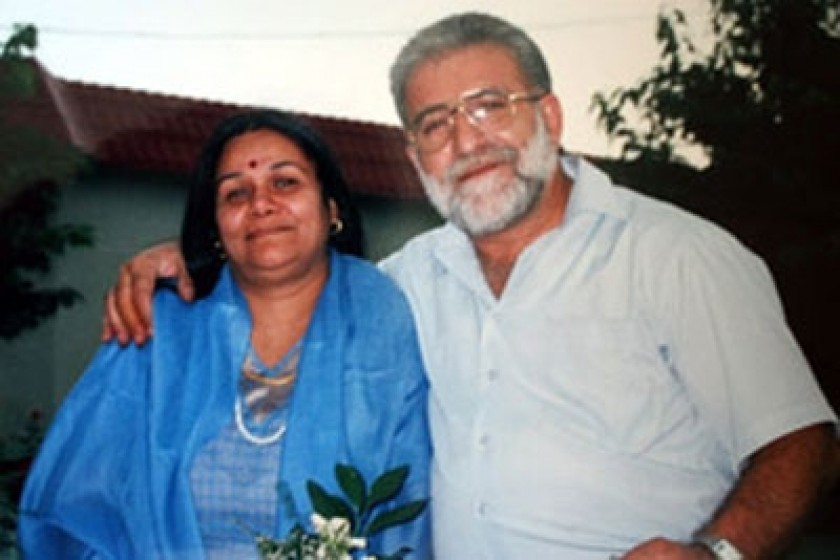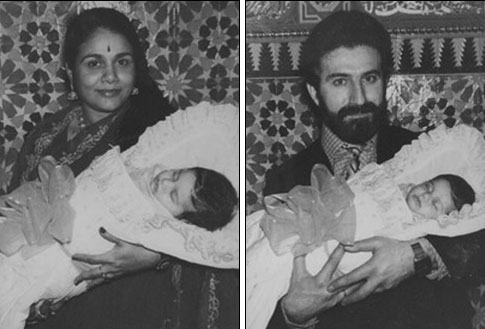
Santosh: An Armenian Woman from the Seventeenth Century
'Let me tell you a story. Someone ate a banana and threw the peel on the ground, I passed by, saw the peel, but did not pick it up, and another passer-by did not notice it, slipped, fell down and broke a leg. Who is to blame? The one who threw it, I who did not pick it up, or the one who did not notice it?'
This is Santosh's favorite puzzle. The answer is we all are to blame, because everything is connected in this world, and we all are links in a long chain, and the action of every links action has an impact on the whole chain. This is what Indian philosophy teaches.
Santosh has Agarbatti, sandalwood, burning in her house. The smell of sandalwood mixed with the sounds of Shiv Kumar Sharma's Santoor relaxes both body and mind. It is the smell of India.
Santosh Kumari is Indian. Her name means Princess of Enjoyment. Although she has been living in Armenia for many years and loves Armenia like it was her motherland, she always wears Indian national dress and the symbols of Indian marriage: a red bindi on her forehead and a mengl sutra on her neck
How did Santosh find herself in Armenia?
Santosh was studying Russian language and literature in Saint Petersburg. Once after a concert a young man approached her student friend and said, 'Go and tell your Indian friend that I am going to marry her.' He had seen her for the first time. The young man was an Armenian student, the future artist Edward Sasun.
Of course, Santosh did not say the words "Ayo hnazand em" ("yes, I do") to him immediately. First she got to know her potential husband then started learning Armenian language and history.
"Our histories are very similar," Santosh says. "Both the Armenians and the Indians have always suffered from foreign invaders, have always taken the role of defenders. Through the Armenian history I fell in love with the Armenian people."
Santosh and Edward wrote to their parents about their decision to get married. In his letter to his mother Edward wrote, 'I found a real Armenian girl in Leningrad, but from the 17 th century!'
In the Indian society it is obligatory for a girl to take her husband's name and religion after marriage. Hinduism is not just a religion, but a way of life. One cannot become Hindu, one has to be born Hindu. No one denies Hinduism easily. Thus, the Indian parents' concern was understandable.
And as for the Armenian parents, for them Santosh was a foreigner, which was almost equal to an alien.
Along with other close relatives they flew to Leningrad to meet their future daughter-in-law.
"My future brother-in-law told me, "In Sasun (Edward's native village) we have a tradition: a daughter-in-law has to wash her father-in-law's feet." His words sounded like a test for foreigners. But in India, we worship our elders and wash their feet every day.
Apart from being a sign of respect, it has another meaning as well. When your left hand touches the elder's right foot and your right hand touches his left foot a cross of energies happens which has very good impact on your both mental and physical health.
So, I brought a basin with water and washed my father-in-law feet. Instead of shocking me, they were shocked," Santosh laughs.
After getting married in Russia, Santosh and Edward decided to make a wedding party in Armenia and India as well.
Santosh was looking forward to coming to Armenia.
'My husband was seducing me with the indescribable Nature of Armenia, and especially Sasun, the place he was born in.'
'My first impression of the beautiful nature was disappointment. For an Indian, beautiful nature means a lot of tall green trees, colorful flowers, and green fields. On the way to the village of Shgharshi there were only stones, stones, stones.'
After spending some months in the village, Santosh fell in love with the endless range of mountains and learnt perfect Armenian in four months.
One morning she started baking bread in the tonir like a real Armenian village woman. This brought her into the hearts of both her parents'-in-law and the villagers'. Very soon many people even start calling Sgharshi an Indian village.
 |
Another 'test' was waiting for Santosh in the Armenian Church during the baptism of her eldest daughter.
"Are the parents baptized?" the priest asks.
"Not the mother," Edward replies.
Santosh was told that in order to baptize the child in the Church both parents had to be baptized as Christians. That would mean adopting another religion which she did not know much about. She tried to protest but neither the priest, the godfather, nor her husband supported her. Thus Santosh becomes a Christian.
'I had to learn my new religion thoroughly,' Santosh laughs, 'Now I am perhaps a better Christian than many born Christians. After all, all religions say the same thing but with the different words.'
Santosh and Edward have five children. They both believe this number should be a minimum for all women, especially for Armenian ones. Four of the children have Armenian names and all five consider themselves not "half Armenian, half Indian , but "100% Armenian."
The two boys, David and Hayk, are going to serve in the Armenian Army after graduating from school.
'They just live with that desire. I hope they will never be disappointed in the Army,' Santosh says.
'India has a professional Army. Here it is hard to escape from service; there it is hard to get admitted into the Army,' she laughs.
What other essential differences are between the Indian and Armenian societies?
'When we moved to Armenia, the first thing that struck me was the attitude towards woman. In Sasun, as in India as well, a woman does not sit at the table. In India she has to bring hot roti (Indian round, flat bread) to the table and be attentive to every guest'
But despite some similarities, the Indian woman is much more privileged than the Armenian woman.
In India the woman is associated with Lakshmi. Lakshmi is a goddess of luck and also money. All the workers in the family give their money to the housewife: she knows how much to spend so that there is enough for everything till the next salary.
The Armenian woman is oppressed in society. She carries on her shoulders most of the household chores: she works, cares for children, makes meals and cleans the house.
In India every family has a special person from the lowest caste who cleans only the toilet. Another man cleans the house; another one is responsible for meals. Almost all families can afford it because such labor is very cheap in India.
'I am a Candidate of Philological Studies, have several high diplomas, and am a master of reiki and ayurvedic massage, and I come to Armenia and am told I have to do all the housework alone, which by the way, takes most of your time. That was really shocking for me.'
'But in general, our cultures are similar; let us not forget that both nations are Aryans. Even our languages are very similar (Santosh is a Hindi language professor at YSU); they have the same roots.'
'Before the Aryans arrived, India was inhabited by Dravidians. When the Aryans came to India, the two became assimilated and created an Aryan-Dravidian civilization. It was at that time that the famous Indian epics the Ramayana and the Mahabharata were written.
In these epics, the women call their sons ari putr , which means son of Arians or suri vnchi , which means people of Sun.
Vedas, Hindu sacred texts, also were brought to India by the Aryans. The first Aryans were none other than Armenians-it is there in the books as well.
80% of Sanskrit resembles Grabar (old Armenian). Sanskrit was brought to India by Aryans. Apparently the phonation of some words has changed now but the roots are the same. For example in Armenian cheese is panir, in Hindi is pnir,
Orange-narinj-narngi
Carrot-gazar-gazr
Crowd - ambokh -amboh
Man- mard-mrd
Crown - tag-taj
Glass- shusha-shushi
There are many words like these.
Now Santosh is working on the first Hindi-Armenian dictionary. One of her students is translating the Mahabharata into Armenian.
Santosh herself has translated Akhtamar and Adana into Hindi. Now she is translating the Armenian epic David from Sasun.
"I hope that some day these translations will be published. I also have a desire that Indian directors will once make David from Sasun into movie, as they did it with the Ramayana and the Mahabharata."
Photos by Onnik Krikorian
 Videos
Videos Photos
Photos
Comments (5)
Write a comment